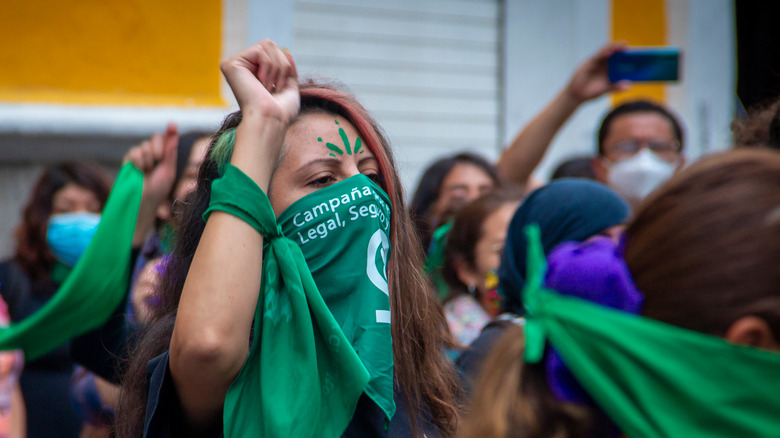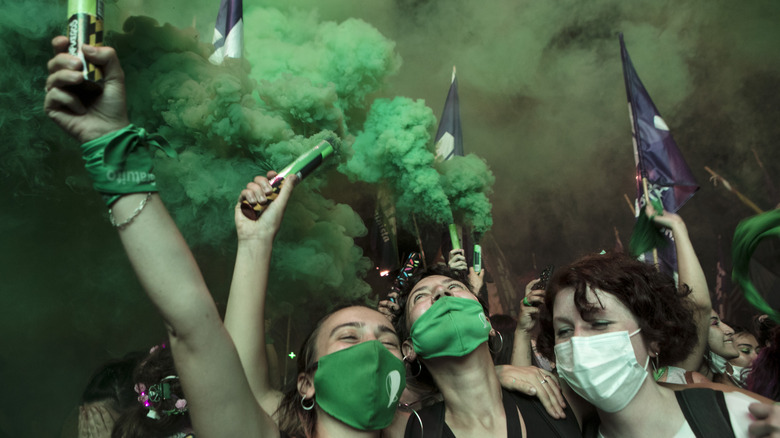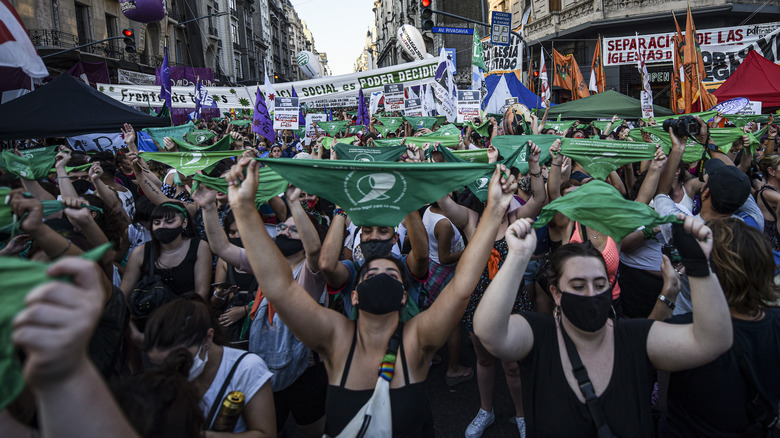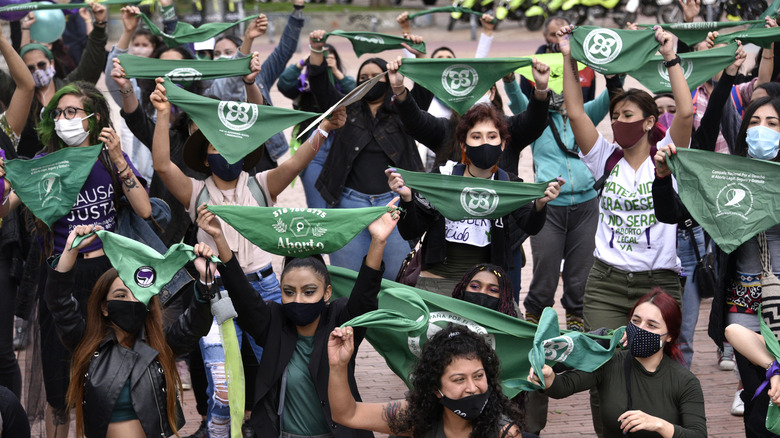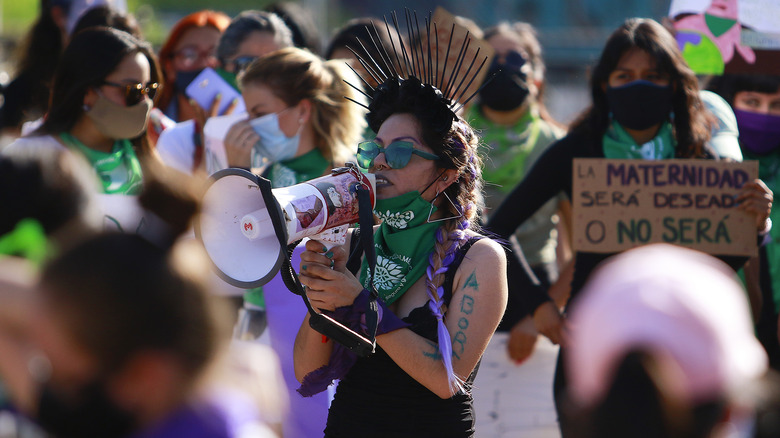The Reason People Are Wearing Green At Abortion Rights Protests
We may receive a commission on purchases made from links.
"They should have never given us uniforms if they didn't want us to be an army," Margaret Atwood wrote in "The Handmaid's Tale" (via Good Reads). In Season 1, Episode 10 of the television adaptation, June makes the same statement as a group of women dressed head-to-toe in red and ready to take back their bodies walk together (via IMDb). While the handmaids in Atwood's dystopian world were dressed in red, a different color emerged as the symbol of feminism in Latin America.
King's College explains that getting a pañuelo verde, or green scarf, is seen as a "feminist rite of passage" in Latin America. They are worn more than just at marches and rallies. Wearing a pañuelo verde is intentionally expressing your "feminist identity," despite the negative attention it can draw. But the green scarf is also a symbol of solidarity; it's a signal that you're not alone in this fight, not unlike the handmaid's red dress.
In the United States, Bustle reports green bandanas have been replacing the pink cat hats popular in Trump-era women's marches. In the wake of the Supreme Court's decision on Dobbs v. Jackson's Health Organization, which reverses major federal protections of privacy and abortion, protests and green bandanas are popping up everywhere.
While the color green might have new symbolic meaning in the United States, its origins stemmed from the work accomplished by the original decision in Roe v. Wade.
Green has its origins in Argentina's fight for reproductive rights
The United States Supreme Court's decision in Roe v. Wade was a flashpoint for reproductive rights not just in the United States, but also in Latin America. There, the demand for bodily autonomy built off the success of Roe and evolved into what activists call Ola Verde, or "green wave," per Ms. Magazine.
The green wave officially started growing in Argentina in 2003 during the 18th National Women's Meeting where abortion was one of the group's main demands for the first time in the meeting's history, according to Le Monde. Mara Alanis explained that it was during that meeting that she suggested green scarves as the group's "rallying symbol."
This symbol originates with the Mothers of the Plaza de Mayo, The Washington Post explains. In the late 1970s, women began protesting outside the presidential palace in Buenos Aires. They wore white scarves made from cloth diapers to symbolize their missing sons and daughters who were taken by the military. Alanis's friend, Susana Chiarotti, suggested green as the color of nature and growth. Chiarotti's motivation? To take back the term "life."
For Alanis, Chiarotti, and others, that's what abortion advocacy is about: giving someone their best life. King's College explains that many advocates have even adopted the slogan, "La maternidad será deseada o no será." Translated to English, it means, "Motherhood will be wanted, or it will not be at all."
Wearing green is about more than just abortion
Green really caught on as the color for abortion advocacy in 2015 after the #NiUnaMenos, Not One Woman Less, campaign, per Refinery 29. By 2018, green scarves could be seen on the streets of Argentina as protests for reproductive rights began both to increase and spread to other Latin American countries. "I'll never forget what it was like to march through the streets of Buenos Aires with thousands of women and girls in pañuelos verdes (green handkerchiefs)," Giselle Carino, Fòs Feminista's CEO, explained on the organization's website.
The women, girls, and other advocates were marching not just for the freedom to choose to be pregnant, but also for unrestricted access to medical care. The Guardian reports one woman spent nearly three years in jail following a miscarriage, and another was refused treatment when she was having life-threatening complications following a self-managed abortion. These situations could be some of the far-reaching effects of Roe's reversals in the United States.
The decades of demonstrations and activism in Argentina finally paid off in January of 2021 when Argentina finally decriminalized abortion and made the procedure legal up to 14 weeks of pregnancy, The Guardian reports. The law is inclusive to "anyone with the capacity to gestate, including transgender and non-binary people."
The reversal of Roe v. Wade impacts more than just the United States
Where Argentina is making history in joining countries expanding abortion rights, the United States is now restricting access. Lieta Vivaldi, co-director of ABOFEM, told Al Jazeera that, "the United States, for better or for worse, has always been a leader for the region and a decision like this is very negative." But Vivaldi says advocates, activists, and hopefully other countries, can look to Argentina, Colombia, and Chile as examples on how to handle reproductive healthcare.
This is why New York Congresswoman Nydia Velazquez wore a green scarf as she marched to the U.S. Senate with other members of Congress in May 2022. What she and others were trying to do was protect Roe v. Wade. In an email to Refinery 29, Velazquez explained that she sending a message to women in the United States and in Latin America, too, that they were all marching together. "The plight is the same, that safe, legal, and accessible abortions is a fundamental right for women," she wrote. The fall of Roe v. Wade, she added, would remove the United States as a world leader, something Latin American abortion advocates agree with.
Solidarity, in spite of borders, is what's necessary to keep expanding women's rights and access to healthcare across the globe.
Abortion advocates say the green tide is coming to the United States
Research has shown that criminalizing abortion doesn't stop people from having abortions, according to The New York Times. it just prevents people from accessing safe procedures. Abortion rates are actually higher in countries that have stricter laws.
When asked how she feels about Americans wearing green, Marta Alanis told Le Monde that it is, "a great honor, personally and collectively, that green is now being taken up in the United States." Before, she explained, the relationship between Latin America and the United States was limited to "dictatorships, military bases, and poverty." Now, she says, "The Latin American green tide is coming to the United States to contribute to the liberation of women."
Green has even been seen worn by activists in Poland, where the country implemented abortion restrictions, according to the NYT.
Alanis isn't the only advocate happy to see green spreading to American marches and protests. "It is proof that we are fighting the same energies all over the world, that we have the same goals," one Argentine woman told Le Monde. She added that, "not only is patriarchy a system that dominates and oppresses us all over the planet, but that feminism is an international movement without borders."
